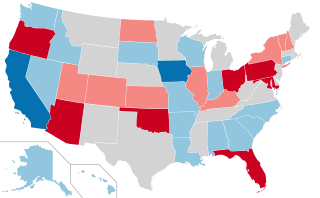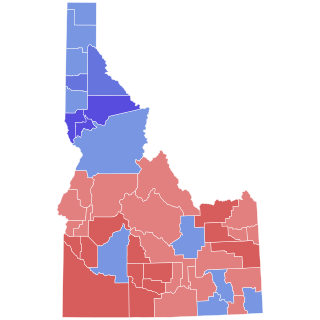
The 1972 United States Senate elections were held on November 7, with the 33 seats of Class 2 contested in regular elections. They coincided with the landslide re-election of Republican President Richard Nixon. Despite Nixon's landslide victory, Democrats increased their majority by two seats. The Democrats picked up open seats in Kentucky and South Dakota, and defeated four incumbent senators: Gordon Allott of Colorado, J. Caleb Boggs of Delaware, Jack Miller of Iowa, and Margaret Chase Smith of Maine. The Republicans picked up open seats in New Mexico, North Carolina, and Oklahoma, and defeated one incumbent, William B. Spong Jr. of Virginia.

The 1968 United States Senate elections were elections for the United States Senate. Held on November 5, the 34 seats of Class 3 were contested in regular elections. They coincided with the presidential election of the same year. The Republicans picked up five net seats in the Senate. This saw Republicans win a Senate seat in Florida for the first time since Reconstruction.

The 1966 United States Senate elections were elections on November 8, 1966, for the United States Senate which occurred midway through the second term of President Lyndon B. Johnson. The 33 seats of Class 2 were contested in regular elections. Special elections were also held to fill vacancies. With divisions in the Democratic base over the Vietnam War, and with the traditional mid-term advantage of the party not holding the presidency, the Republicans took three Democratic seats, thereby breaking Democrats' 2/3rds supermajority. Despite Republican gains, the balance remained overwhelmingly in favor of the Democrats, who retained a 64–36 majority. Democrats were further reduced to 63–37, following the death of Robert F. Kennedy in June 1968.

The 1964 United States Senate elections were held on November 3. The 33 seats of Class 1 were contested in regular elections. Special elections were also held to fill vacancies. They coincided with the election of President Lyndon B. Johnson by an overwhelming majority, to a full term. His Democratic Party picked up a net two seats from the Republicans. As of 2023, this was the last time either party has had a two-thirds majority in the Senate, which allowed the Senate Democrats to override a veto, propose constitutional amendments, or convict and expel certain officials without any votes from Senate Republicans. However, internal divisions would have prevented the Democrats from having done so. The Senate election cycle coincided with Democratic gains in the House in the same year.

The 1960 United States Senate elections coincided with the election of John F. Kennedy as president on November 8, 1960. The 33 seats of Class 2 were contested in regular elections. A special election was also held on June 28, 1960, for a mid-term vacancy in North Dakota where Democrats flipped a seat to expand their majority to 66–34. As Majority Leader Lyndon Johnson was elected Vice President, Mike Mansfield became the new majority leader.

The 1958 United States Senate elections were elections for the United States Senate which occurred in the middle of President Dwight D. Eisenhower's second term. Thirty-two seats of Class 1 were contested in regular elections, the new state of Alaska held its first Senate elections for its Class 2 and 3 seats, and two special elections were held to fill vacancies.

The 1958 California gubernatorial election was held on Tuesday November 4, Democratic candidate Pat Brown won the first of his two terms as governor of California against Republican senator William Knowland.

The North Carolina United States Senate election of 1972 was held on 7 November 1972 as part of the nationwide elections to the Senate, and coinciding with the 1972 presidential election. The general election was fought between the Republican nominee Jesse Helms and the Democratic nominee Rep. Nick Galifianakis. Helms won the election, becoming the first Republican to win a Senate seat in North Carolina since 1897, and the first to hold this seat since 1871.

The 1922 United States Senate election in Massachusetts was held on Tuesday, November 7. Incumbent Republican Senator Henry Cabot Lodge was re-elected to a fifth term in office over Democrat William A. Gaston.

The 1960 United States Senate election in North Carolina was held on November 8, 1960. Incumbent Democratic Senator B. Everett Jordan was re-elected to a full term in office, defeating Republican Wilkes County attorney R. Kyle Hayes.

The 1966 United States Senate election in Alaska was held on November 8, 1966. Incumbent Democratic U.S. Senator Bob Bartlett was re-elected to a third term in office in a landslide, defeating Republican dentist Lee McKinley in a rematch of their 1960 race. Bartlett would not complete the term, dying in office on December 11, 1968, following complications after heart surgery. Ted Stevens would be elected to complete Bartlett's term, and would serve for 40 years in the U.S. Senate. This was the last time until 2008 that a Democrat was elected to Alaska's Class 2 Senate seat.

The 1966 United States Senate election in Idaho took place on November 8, 1966. Incumbent Republican Senator Leonard B. Jordan was re-elected to a second term in office over Democratic U.S. Representative Ralph R. Harding.

The 1958 United States Senate special election in North Carolina was held on November 4, 1958. Interim Democratic Senator B. Everett Jordan was elected to complete the unexpired term of Senator W. Kerr Scott, who had died in April.

The United States Senate election in Washington of 1952 was held on November 4, 1952. Incumbent and highly-controversial Republican Harry Cain ran for a second term in office, but was defeated by Democratic U.S. Representative Henry M. Jackson. Jackson would come to serve 30 years as a United States Senator, and this would be his only election to the Senate in which he lost any of the state’s counties.

The 1950 United States Senate election in Iowa took place on November 7, 1950. Incumbent Republican Senator Bourke B. Hickenlooper was re-elected to a second term in office over Democratic U.S. Undersecretary of Agriculture Albert J. Loveland.

The 1954 United States Senate special election in California was held on November 2, 1954, to elect a U.S. Senator to complete the unexpired term of Senator Richard Nixon, who resigned on becoming Vice President of the United States following the 1952 presidential election. Incumbent Republican U.S. Senator Thomas Kuchel, who had been appointed by Governor Earl Warren, won election to the remainder of the term, defeating Democratic nominee Sam Yorty.

The 1966 United States Senate election in Delaware took place on November 8, 1966. Incumbent Republican U.S. Senator J. Caleb Boggs was re-elected to a second term in office. As of 2024, this is the last time Republicans won Delaware’s Class 2 Senate seat.

The 1966 United States Senate election in Iowa took place on November 8, 1966. Incumbent Republican Senator Jack Miller was re-elected to a second term in office over Democrat E.B. Smith.

The 1966 United States Senate election in Kansas took place on November 8, 1966, concurrently with elections to the United States Senate in other states as well as elections to the United States House of Representatives and various state and local elections.

The 1966 United States Senate election in Kentucky took place on November 8, 1966. Incumbent Republican Senator John Sherman Cooper was elected to a second consecutive term in office, defeating Democrat John Y. Brown Sr. in a rematch of the 1946 special election.




















